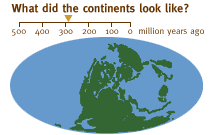Explore an Era:
Permian
280 - 248 million years ago
Dry climate, extreme temperatures |
Continents merge into single mass |
Gymnosperms dominant species |
Amphibians and reptiles dominant |
None |
|||||
The global geography of the Permian included massive areas of land and water. By the beginning of the Permian, the motion of the Earth's crustal plates had brought much of the total land together, fused in one supercontinent. The climactic effects of these changes were huge--the interior regions of this huge landmass became dry, with great seasonal fluctuations and extremes of temperature. These movements of land masses also resulted in the formation of many mountain ranges. The Appalachian Mountains of the eastern United States are one of several mountain systems that developed about this time.
The expansion of plant forms during the previous period creates much higher oxygen levels during the Permian period, bringing them close to what they are today. The great forests of fern-like plants are replaced by gymnosperms, which are plants that reproduce from seeds. Modern conifers, the most familiar gymnosperms of today, first appear in this period.
The end of the Permian is marked by the largest mass extinction recorded in the history of life on Earth. This mostly affected marine life, causing the extinction of most marine invertebrates, but there was also an extinction of some land forms. These die-offs cleared the way for a completely different form of sea life and opened the way for the Age of Dinosaurs that followed.
